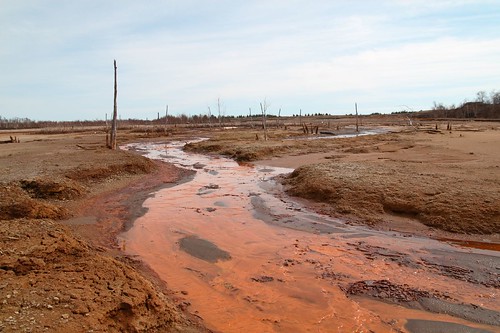Take a moment to view this slideshow of photos of the devastation wrought by the largest nickel mine in the world upon a landscape that was once not too different from the Yellow Dog.
More on Inco & Sudbury:
The Inco Mine at Sudbury, Ontario shows photos of the smelting facility, which is probably the single largest point-source for acid rain-causing emissions on the entire North American continent.
Rio Tinto looks to Sudbury for R&D explains how Kennecott parent company Rio Tinto is looking to Sudbury for mining knowledge.

Looks like a typical tailings basin to me that is still in use and has not been reclaimed yet. Not too different from those of local iron mines. It is my understanding that the tailings are going to be processed ,mixed with concrete and put back into the mine. Therefore you you not have a surface tailings basin correct?
The tailings pile(s) will sit out in the elements, free to react with oxygen and water to produce AMD, until all of the ore has been extracted from each level of the mine. It is true that they plan on refilling the holes with a mixture of concrete and tailings, BUT it will sit on land during the mining. Also the “rubble” from the crushing and transportation of the ore will be strewn all over the surface facility and that will be exposed long enough to generate AMD.
The tailing piles will be contained in a lined storage facility, so it wont be going into the soil. As far as the rubble all over the surface, before it can leave that area, it will have to go through a washing area. The entire sites water from rain, and the rubble from the mine will be going to containment areas, that will then go to the water treatment facilty to be processed. IF there is any AMD, it will be contained…
I ask anyone in doubt to take a mine tour. I did and it will ease your mind. It eased mine